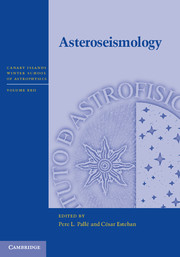Book contents
- Frontmatter
- Contents
- List of contributors
- List of participants
- Preface
- Acknowledgments
- Abbreviations
- 1 Sounding the solar cycle with helioseismology: Implications for asteroseismology
- 2 Learning physics from the stars: It's all in the coefficients
- 3 Solar-like oscillations: An observational perspective
- 4 Studying stars through frequency inversions
- 5 A crash course on data analysis in asteroseismology
- 6 An observer's views and tools
- 7 Asteroseismology of red giants
Preface
Published online by Cambridge University Press: 05 December 2013
- Frontmatter
- Contents
- List of contributors
- List of participants
- Preface
- Acknowledgments
- Abbreviations
- 1 Sounding the solar cycle with helioseismology: Implications for asteroseismology
- 2 Learning physics from the stars: It's all in the coefficients
- 3 Solar-like oscillations: An observational perspective
- 4 Studying stars through frequency inversions
- 5 A crash course on data analysis in asteroseismology
- 6 An observer's views and tools
- 7 Asteroseismology of red giants
Summary
Background
The XXII Canary Islands Winter School of Astrophysics, organized by the Instituto de Astrofísica de Canarias (IAC), focuses on the new advances and challenges that asteroseismology provides in the domains of stellar structure, dynamics, and evolution. Every year the Winter School welcomes around 60 Ph.D. students and young postdocs and provides a unique opportunity for them to broaden their knowledge in a key field of astronomy.
Scientific rationale
When oscillations of the Sun were first discovered, a new era of science began. The observed frequencies could be used to probe deep into the stellar interior, the only measurements that could possibly pierce the stellar surface. Today, “helioseismology” has been responsible for some of our deepest understanding of the Sun: we know the radial and longitudinal rotation profile of the interior, we have measured the depth of the outer convection zone, and it has helped solve the so-called neutrino problem when the observations and theory predicted a much hotter central temperature than the observed neutrinos predicted. Today, these seismic observations are not only available in much higher quality, but they are also available for hundreds of other stars. In the last few years, many space missions (CoRoT and Kepler) have produced these data of exquisite quality, and for the first time we are in a position to study the Sun in the context of other stars, measure the fundamental parameters of single field stars to within 2 percent, learn about diffusion processes and the effects of rotation on the stellar structure, and test opacities and equations of state in extreme conditions.
- Type
- Chapter
- Information
- Asteroseismology , pp. xiii - xivPublisher: Cambridge University PressPrint publication year: 2014

